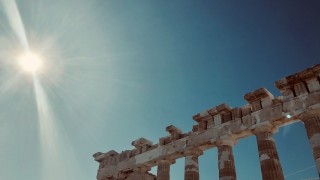"...beyond the obvious benefits of historical learning and art and curatorial practice, the program allowed me to broaden my own worldview of both foreign and familiar spaces."
As a student of an institution founded on traditional Greek values, studying abroad in Athens was not just a rewarding opportunity in its own right, but a lens through which I could more critically examine my past and future educational experiences back at Columbia. During the program, I visited the Parthenon, attended a play by Euripides in an ancient Greek theater, viewed ancient sculptures of The Histories’ Kleobis and Biton, and even saw what was supposedly the Mask of Agamemnon from a grave circle in Mycenae. These encounters helped me contextualize what I learned in Art Hum and Lit Hum and would serve as useful foundations for an architectural history class I would take the following semester.
The bulk of the program material, however, lay in the history of modern Greece, a significant element of which was Western Philhellenism and the foreign interventionism that resulted. Assessing Columbia’s neoclassical campus and core curriculum, epitomized by the eight exclusively Greek and Roman names on Butler’s front façade, it was clear that the university was from its conception highly bought into this Philhellenic impulse. On a larger scale, learning about American neocolonialism in Greece, particularly its support of the military junta, also allowed me to better understand the history of my own country in relation to the rest of the world. In other words, beyond the obvious benefits of historical learning and art and curatorial practice, the program allowed me to broaden my own worldview of both foreign and familiar spaces.
